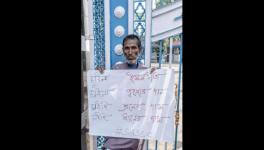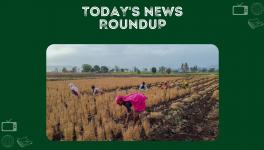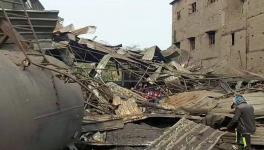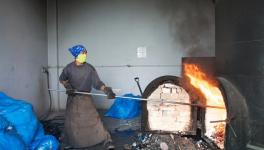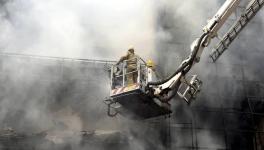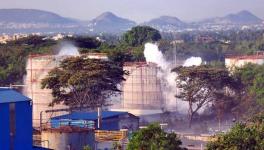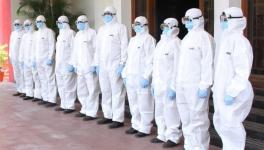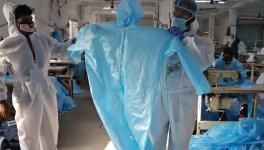In ‘Villages of Widows’ Pensions a Sliver of Hope
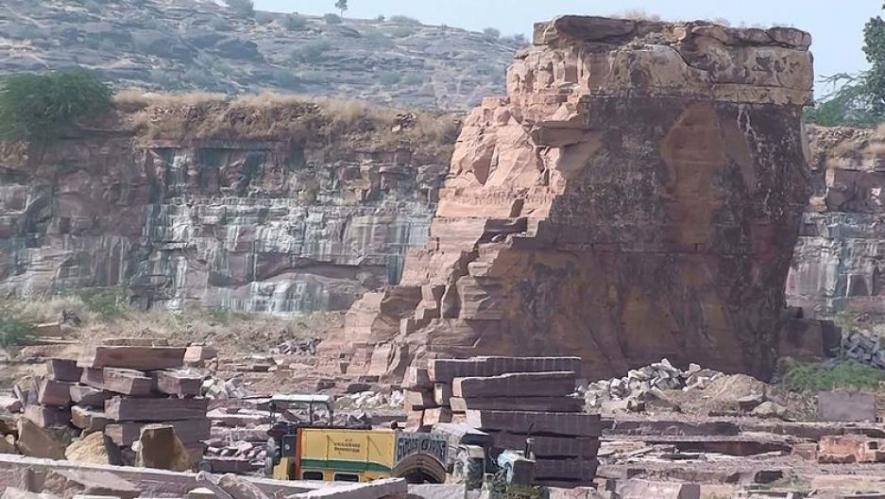
Pneumoconiosis is an umbrella term that refers to occupational diseases of the lungs, affecting workers in mining, quarrying, construction, and mineral processing industries. Representational Image. | Image Courtesy: Health Issues India
In October 2019, Rajasthan Chief Minister Ashok Gehlot announced that events to commemorate 150 years of Gandhi’s birth would continue for another year, since general elections in 2019 had not allowed people to remember Gandhi as earlier planned. Among the announcements the CM made was a new Pneumoconiosis Policy.
Pneumoconiosis is an umbrella term that refers to occupational diseases of the lungs, affecting workers in mining, quarrying, construction, and mineral processing industries. Those working in proximity with silica, coal dust or asbestos inhale the dust, which settles in the lungs. Dust particles are attacked by the immune system, leading to swelling. This gradually leads to areas of hardened and scarred lung tissue, and death through progressive debility in the lungs. The disease is known as asbestosis, silicosis and coal workers’ pneumoconiosis depending on the type of dust inhaled. In common parlance “silicosis” is used to refer to “pneumoconiosis”.
The state’s policy on detection, prevention, control and rehabilitation of those suffering from pneumoconiosis treats them at par with the differently-abled. A pension of Rs 1,500 per month is offered to patients and once the patient dies, his family gets social security benefits under the social justice department, including widow pension and child care relief. Widow pension varies from Rs 750 to Rs 1,500 depending on the woman’s age.
Suresh Gupta, additional director (pension) in the social justice department, says the pension has been disbursed to more than 10,500 beneficiaries since January and the department is adding new bank details and Aadhaar numbers of patients to the payment schedule. “Every certified pneumoconiosis patient in the state is eligible to receive pneumoconiosis pension from 16 December 2019 onwards, irrespective of the date of certification,” he says.
Bihari Lal, a 40-year old silicosis patient from Bada Gaon village in Dausa, however, has still not started receiving pension despite being certified by the pneumoconiosis board. “I worked in a mine for 17-18 years. In 2016 I had to stop working after I was diagnosed with silicosis. I received Rs 1 lakh from the government. I need the pension as I cannot work any more. I am undergoing treatment for silicosis at a government hospital, but have to purchase expensive medicines every month as they are not available at any government facility. I have undergone two operations, and am too weak to leave my bed and ask around about my pension,” he says.
Manohar Saini from Gudha Katla in the same district, who worked in a stone-carving factory before being diagnosed with silicosis in the end of 2018, says he started getting his pension in April. “When the pension came into my account I received a message on my phone. However, I have not yet received the one-time financial assistance of Rs 3 lakh since my records were erroneously entered twice, and I had to wait for this to be rectified. Later I was told that financial assistance has been put on hold because the government’s budget was not enough. I am still waiting for the financial assistance of Rs 3 lakh as that would help me meet my medical expenses,” he says.
His brother Dolaram Saini was diagnosed with silicosis in 2016. For 25 years he earned a livelihood doing odd stone-carving jobs in Dausa. Earlier this year he received a one-time financial assistance of Rs 2 lakh, which is less than the revised amount. The father of three had to stop work soon after he was diagnosed with silicosis. His wife takes up MG-NREGA work to support the family.
“Even walking a distance of half a kilometre makes me breathless now. My brother and I are under treatment for silicosis at a private hospital, as the treatment we received from the government hospital was not helpful. I have to spend on monthly medicines, doctors’ fees and the bus fare to Jaipur. The bills are high and the money we get from our agricultural land is not enough. I received a monthly pension for April and May and hope this continues,” he says.
Jodhpur, Bundi, Karauli, Alwar, Bharatpur, Dholpur and Bhilwara districts have the largest number of stone mines. In Rajasthan alone, there are 17,000 silicosis patients now registered with the government. The state has 3 million mine workers employed in 33,000 mines—the highest in the country. Only 3,000 mines are on the records of the regulatory authority, so the safety of workers has clearly been sidelined by employers.
Rana Sengupta of the NGO Mine Labour Protection Campaign in Jodhpur remembers that when he first started work in the district over a decade ago, he had made a presentation at a meeting, stating that several widows in a pocket of the district had lost their husbands to tuberculosis. His audience wondered why people were dying in such large numbers of a disease that could be treated. Sengupta returned to check medical records of the people who had died, but found that several of them had already been discarded. His search led him to discover that mine workers in the area were also affected by silicosis.
Since 2016, when Rajasthan launched its portal to track the disease, 1,800 people have died of it. There is no cure; patients can be prevented from further exposure to silica to prolong life. Silicosis prevention methods, though, are now well-established. Precautions should be taken by mine employers to ensure dust does not fill the air which workers inhale. This can be best done by using water while drilling.
Dr. M K Devarajan, former member of the Rajasthan State Human Rights Commission, says that wet drilling can solve almost all of the pneumoconiosis problems. While the drilling machine is being operated, a jet of water also starts simultaneously, keeping dust suppressed. However, water is a precious resource in Rajasthan and miners avoid wet drilling because it costs more.
“Legislation requiring wet drilling already exists. It is mandatory under the Metalliferous Mines Regulations, 1961, but the central government fails to enforce it,” Devarajan says. The regulation specifies: “The owner, agent or manager of every mine shall take such steps as are necessary for the minimizing of emissions of dust and for the suppression of dust which enters the air at any work place ……..and for ensuring that the exposure of workers to respirable dust is limited to an extent that is reasonably practicable but in any case not exceeding the limits that are harmful to the health of persons.”
Activist Nikhil Dey of Mazdoor Kisan Shakti Sanghatan says compensation for those already affected should not eclipse the focus on prevention. “It is only when the employer is made to pay that they will really understand and get worried….and will start adopting preventive and safety measures in the mines. This framework needs to be in place, along with concurrent accountability.”
With mine workers dying in their 40s, one might wonder why people continue to go to the mines at all, even though some districts in the state now have “villages of young widows” struggling to provide for their children. Once mining starts in an area, there is little else that can be done to earn a living. Agriculture, for instance, is unreliable as it is mostly rain-fed.
Nikhil Dey likens pneumoconiosis to a “blood money disease”. “Society “develops”, as people die; it’s a tragic face of our development model,” he says.
It is in recognition of how the poorest pay with their lives for “development” that the state began to offer compensation in 2013 to those suffering from the disease. The one-time financial assistance has now been revised. Dr. Vikas Bharadwaj of the NGO Dang Vikas Sansthan in Karauli district, says this has caused some confusion: “A widow whose husband was certified prior to the announcement of the pneumoconiosis policy was entitled to Rs. 3 lakh earlier, but now she will only receive Rs. 2 lakh. Her husband had received Rs. 1 lakh on certification, but now certified patients receive Rs. 3 lakh. This stark difference in financial assistance has caused confusion.” Before the District Mineral Foundation Trust (DMFT) was instituted in 2016, the one-time financial assistance was Rs. 1 lakh.
Dr. Bharadwaj says the government must offer publicity and explain how cases will be considered to save widows anguish. He however has no doubt that the policy, implemented well, will go a long way in offering patients and their families relief.
The seeds of the policy were sown in 2014, when Dr. M. K. Devarajan submitted RHRC’s ‘Special Report on Silicosis’ with 59 recommendations for silicosis prevention, detection, compensation and rehabilitation to the state government. Pneumoconiosis experts, human right activists, medical professionals and the state authorities later pitched in to draft the policy. Silicosis patients, in large numbers, also gathered for public hearings and struggled to raise slogans, drawing some media attention.
In his campaign ahead of the state Assembly election in 2018, Gehlot reached out to the silicosis patients and assured the three million mine workers that their concerns would be addressed once he came to power. The demands of these patients featured in the party manifesto.
There are, however, bottlenecks that still need to be cleared. The nodal agency for the implementation of the Pneumoconiosis Policy is the Specially-Abled Persons Department (SAP). The policy is implemented in collaboration between the departments of Social Justice and Empowerment, Labour, Mines and Health. The government’s pre-occupation with Covid-19 in the past few months has disrupted implementation. The migration of labourers across districts during the lockdown has delayed certification and rehabilitation. Government bodies, now operating with sparse staff, are scrambling to ensure monetary benefits outlined in the policy reach workers.
There are patients with “non-digitalised” records whose details have still to be fed into the online portal. Despite these hiccups, there is hope. Dey says, “Several aspects of the policy are definitely pioneering and progressive, making it the country’s best policy right now.” His concern, though, is the need for coordination between multiple state departments. If the processes are not smooth, patients may be affected.
Authorities say that the disbursement of pension has a backlog now for the digital portal has to be updated to include patients diagnosed with pneumoconiosis before the online portal came into existence. Similarly, offline records of some deceased persons have to be fed into the digital system, so widow pension can be offered seamlessly.
“The existing system has a provision for including non-digitalised patient records, and we will definitely ensure that all such patients are soon added to the database, and their pension will be paid,” says Dr. PK Sisodiya, consultant to BOCW (Building & Other Construction Workers) Welfare Board.
Sisodiya, a silicosis expert, says, “One issue with pneumoconiosis detection is the screening method. All over the world, ILO standards using chest X-rays are adopted for diagnosis. Ideally, every member of the board should be trained on how to use the ILO classification and then diagnose silicosis. Unfortunately, this classification was not provided to majority of the pneumoconiosis medical boards.” These medical boards at the district level is where the certificates that make patients eligible to receive pension and other benefits are offered.
The pneumoconiosis policy states that all medical doctors screening for pneumoconiosis and members of pneumoconiosis boards will be trained in using the ILO classification. One hopes that with proper and timely screening, cases will be detected early. If that happens, life can be prolonged with reduced exposure to the silica dust.
The pneumoconiosis policy also prohibits the manufacture, use and procurement of tools and equipment without proper dust suppression systems, and enjoins employers to adopt “dust control” measures, other than a Personal Protective Equipment programme to be implemented by employers.
Proper registration of all workers:
“We are working towards stringent enforcement of the Mines Act, 1952, for the safety and health of mine workers, and also to hold the mine owners accountable for their actions,” says Kunji Lal Meena, principal secretary of the state’s mining department.
The Mines Act, 1952 requires that mine owners provide compulsory health insurance to their workers, and arrange for their periodical medical examination, besides ensuring protective devices are used along with preventive measures in mines.
“Although the law has been in place, it has not been implemented effectively by the government. The issue we face is that workers are not registered by the mine owners. We feel this is a grey area to be addressed, for which we plan to inspect mines to identify the true count of workers employed, and then take appropriate action against violating mine owners,” Meena says.
MLPC’s Rana Sengupta says loopholes in government policies have been exploited thoroughly by mine owners, to the extent of avoiding the registration of mines and the workers they employ. He says that the MLPC had taken a complaint to the state human rights commission, on the basis of which, in May, the Directorate of Mines and Geology had ordered mine owners to immediately register their workers with the labour department. Another order from the Directorate General of Mines Safety, also passed in May, requires mine owners to reveal the names of all workers in their employ.
Once these two orders are enforced, the state will have an official record of all workers employed in the mining sector. “There can also be a parallel desk for the mine workers to register themselves, so that any discrepancy in reporting the number of workers will show up,” says Sengupta.
Pneumoconiosis fund:
The state has created a separate fund to finance the pneumoconiosis policy. This Pneumoconiosis Fund would receive contributions largely from the District Mineral Foundation Trusts (DMFT), Building and Other Construction Workers (BOCW) Welfare Fund, State Budget and Corporate Social Responsibility (CSR) Funding.
Representative body for mine workers
During the coronavirus crisis, mine workers have been severely impacted by loss of work and no access to government funds as they did not fall under any of the apex bodies. Although the DMFT fund is for the benefit of persons and areas affected by mining related operations, most workers do not have access to these funds as they are not registered by their employers. Moreover, since its inception, there has been slackness in the use of DMFT funds for the welfare of workers and their families, in providing hospitalization benefits, maternity benefits, and education for their children.
This has sparked a debate on whether mine workers of Rajasthan also need a representative welfare board. Sengupta sees the need for a compliance commission and a welfare board, which can be the same institution as well. “Either change the mindset, and bring a regulatory mechanism within the purview of the state government, or develop a compliance commission to protect the workers and to safeguard the industry. We need a welfare board to secure benefits from the DMFT fund and a compliance commission so that the existing gap can be bridged.” While states grant mining licenses, the welfare of miners falls in the Union list, making for a scattering of responsibility to the detriment of workers.
Dr. Sisodiya also seeks an umbrella body for mine workers. “Workers of the stone-processing units in Rajasthan have been brought under the BOCW, so they are represented by this welfare board. It would be beneficial to have mine workers under a similar board.”
A welfare board can be pivotal in ensuring workers’ access to the DMFT funds, and help voice their collective concerns regarding wages, work conditions, and welfare of their families. However the board cannot be a panacea for Rajasthan’s pneumoconiosis issue. Eventually, it is the government that has to introspect and identify the reasons for blatant lapses in enforcing occupational health and safety laws, and ensure strict action against violators.
Instead of spending on post facto “relief” measures alone, the state must also invest in preventive measures to control pneumoconiosis, by providing necessary infrastructure for wet drilling, and suitable protective gear to workers. Despite stringent laws, employers have disregarded this need so far, and the state cannot afford further delay in prevention and control of pneumoconiosis.
In 1995, the WHO and ILO began a campaign to eliminate silicosis by 2030. If Rajasthan succeeds, it will find a place on the global radar and it can help other states meet this target. The policy could herald a new dawn for these vulnerable workers, and the “villages of widows” could be a thing of the past.
Jacquiline Roberts Singh holds an MPhil in Economics from JNU and works as an independent researcher. For this article, she would like to acknowledge inputs from Rosamma Thomas. The views are personal.
Get the latest reports & analysis with people's perspective on Protests, movements & deep analytical videos, discussions of the current affairs in your Telegram app. Subscribe to NewsClick's Telegram channel & get Real-Time updates on stories, as they get published on our website.










